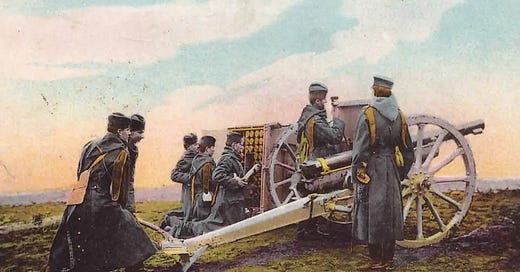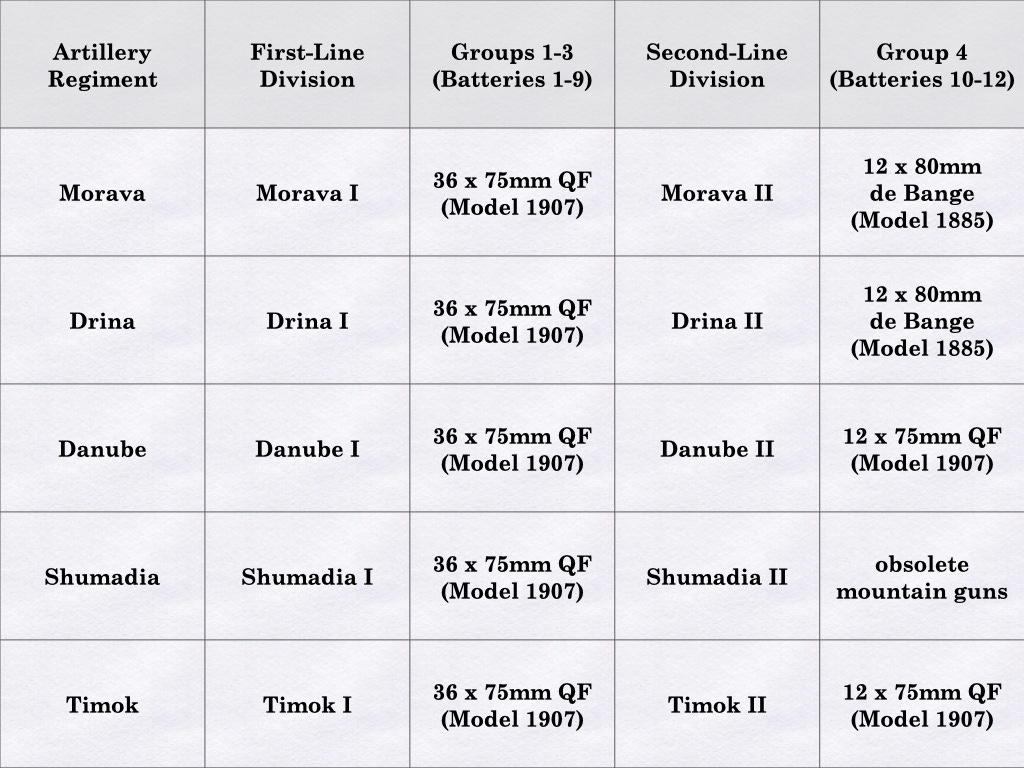Welcome to the Tactical Notebook, where you will find more than four hundred tales of armies that are, armies that were, and armies that might have been. If you like what you see here, please share this article with your friends.
In 1907, the Kingdom of Serbia placed an order with the French firm of Schneider and Company for the materiel for forty-five batteries of field guns, nine batteries of mountain guns, and two batteries of horse artillery. When delivered, these sets of weapons and equipment allowed the complete rearmament of the field artillery of all five infantry divisions, all nine mountain batteries, and both horse artillery batteries of the standing army.
In 1910, the Serbian authorities ordered additional ordnance from Schneider. This order included forty additional batteries of field guns. Like the field batteries of the earlier order, each of these consisted of four 75mm quick-firing field guns (Model 1907) and the accessories (such as limbers and caissons) needed to employ them in the field. (The two horse artillery batteries ordered in 1907 were also equipped with field guns of this type.)
However, only six or so of these equipment sets reached Serbia before the outbreak of the First Balkan War in October of 1912. (Indeed, in September of 1912, a shipment of nine or so field gun batteries destined for Serbia had been confiscated by Ottoman authorities at the port of Salonica.) As a result, nine of the fifteen new field artillery batteries raised upon mobilization went to war with obsolete ordnance. (These new batteries were assembled into three-battery groups and assigned, at a rate of one group per division, to second-line infantry divisions.)
All nine of mountain batteries of the standing army, each of which was armed with four Schneider 70mm mountain guns (Model 1906), belong to a single regiment. Upon mobilization, this regiment formed four new batteries, each of which was armed with 80mm mountain guns (Model 1885 de Bange.) Not to be confused with the Model 1885 de Bange field guns issued to the fourth battalions of the Morava and Drina field artillery regiments, these obsolete weapons were identical to those issued to the fourth battalion of the Shumadia field artillery regiment.
The Serbian Army formed no second-line horse artillery batteries. Thus, when the two horse artillery batteries of the standing army were mobilized, any reservists who were surplus to the needs of those units found homes in artillery batteries of other sorts. (As the horse artillery batteries used the same 75mm quick-firing guns as most of the field batteries, it would have made good sense to assign the former horse artillerymen to field batteries.)
Where field batteries were permanently assigned to infantry divisions and the two horse artillery batteries belonged to the Cavalry Division, mountain batteries were formed into three-battery groups that were, in turn, assigned to armies in the field.
Sources:
Löbells Jahresberichte for 1910 (page 237), 1912 (pages 223-227), and 1913 (pages 214-221)
“Fortschritte der Fremden Armeen: Serbien” Streffleurs Militärische Zeitschrift (May 1911) pages 801-806
“Nouvelles Militaires: Serbie” Revue Militaire des Armées Étrangères (September 1912) pages 218-226






